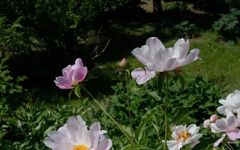Have you heard of Bai Shao (White Peony)? It is an essential component of the Si Wu Tang (Four Substance Decoction) used in stewed duck soup, a common ingredient in popular herbal face masks, and a well-known remedy for nourishing blood and regulating menstruation, with over two thousand years of medicinal history. Additionally, it is a favored herb in the writings of the medical sage Zhang Zhongjing, frequently mentioned in the Shang Han Lun (Treatise on Cold Damage). Today, let’s take a closer look at Bai Shao!

Confused about Shao Yao, Bai Shao, and Chi Shao?

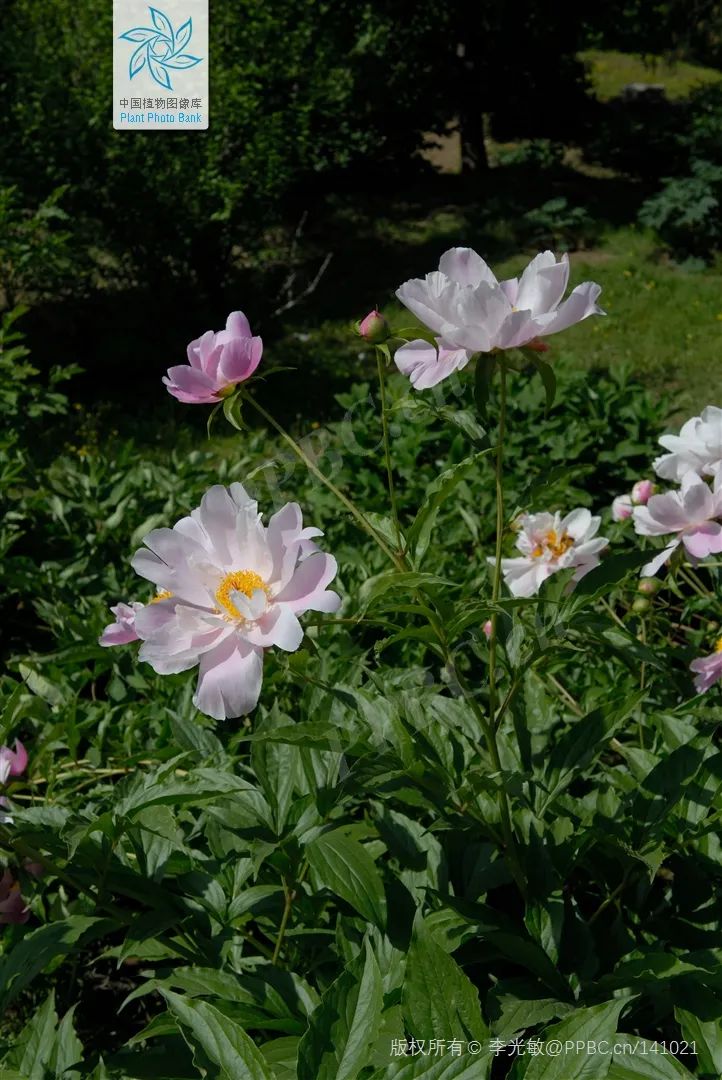
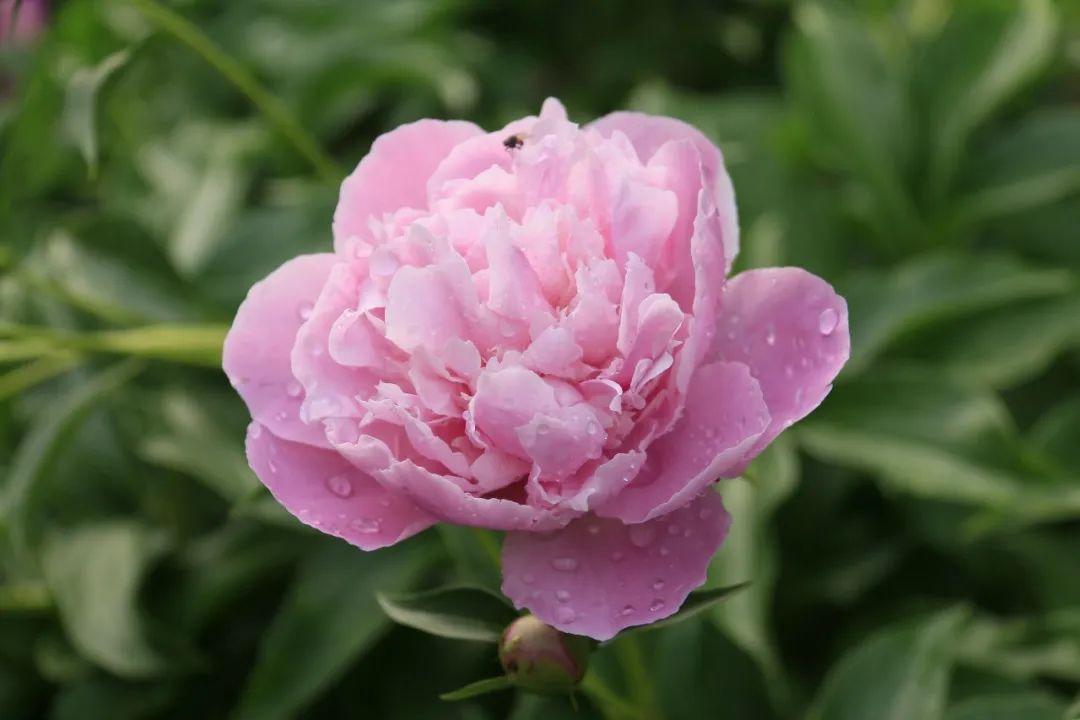
When discussing Bai Shao, it is often unavoidable to mention Shao Yao and Chi Shao. These three terms may sound similar, but there are significant differences among them. Don’t worry, let me explain!

Detailed Differences

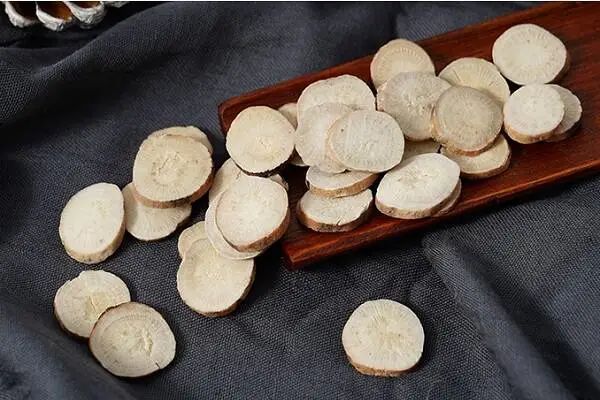
Bai Shao


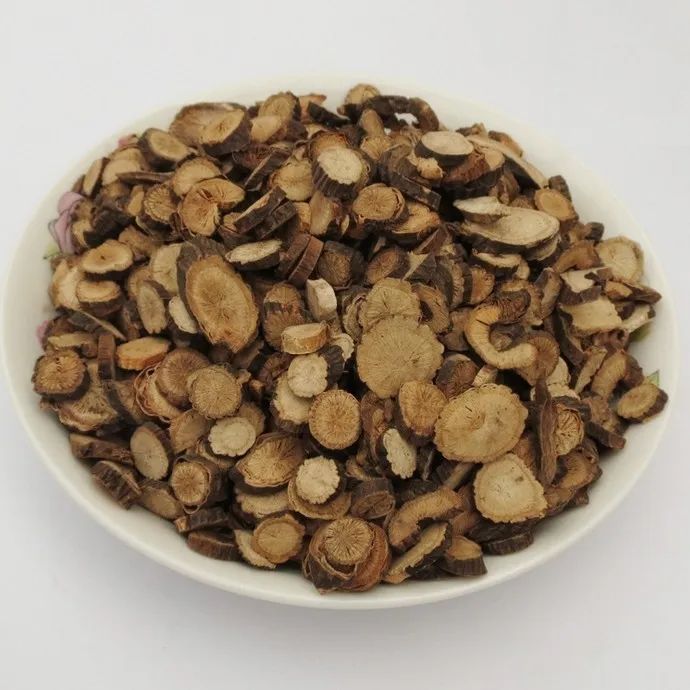
Chi Shao
Shao Yao is more commonly used today as a plant name. Both Chi Shao and Bai Shao are derived from Shao Yao, but Chi Shao has an additional source known as Chuan Chi Shao.
Before the Southern and Northern Dynasties, there was no distinction between Chi Shao and Bai Shao. During the Southern and Northern Dynasties, Tao Hongjing first proposed the differentiation of Shao Yao into Bai Shao and Chi Shao, but did not clearly define them. Since the Song and Yuan Dynasties, methods of differentiation based on flower color and root color have been proposed. In the Ming Dynasty, methods of classification based on harvesting and processing were established and have been continued to this day. In modern times, methods of classification based on different growth patterns and processing techniques have been established for Chi Shao and Bai Shao.
Clinically, aside from their different appearances, Bai Shao and Chi Shao also have significant differences in their main effects. Bai Shao tends to regulate menstruation and stop sweating, making it suitable for treating pale complexion, dizziness, and irregular menstruation. Chi Shao, on the other hand, is more inclined to clear heat and liver fire, making it very suitable for treating conditions like blood heat and pain. Chi Shao has excellent anticoagulant properties, and if a patient has high blood lipids, Chi Shao can help lower them and reduce inflammation. Additionally, Chi Shao is also effective in enhancing immunity.
According to research, the origins of “Chi Shao” and “Bai Shao” mentioned in prescriptions after the Song Dynasty are basically consistent with those referred to today. Therefore, when prescribing, one should follow the ancient records. For prescriptions that still refer to “Shao Yao” after the Song Dynasty, the original medicinal material can be determined through its functional indications and the evolution of the formula.

Source

This product is the dried root of the plant Paeonia lactiflora Pall. from the family Ranunculaceae.

Plant Morphology




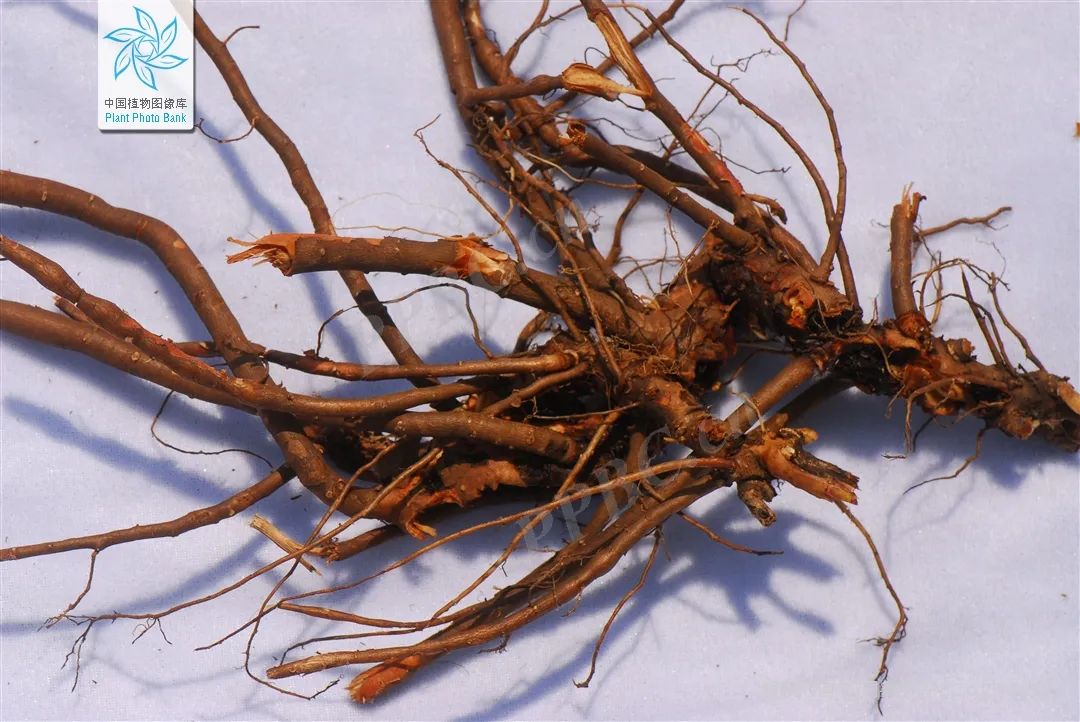
This is a perennial herbaceous plant.
The roots are thick and branched, dark brown.
The stems are 40-70 cm tall and hairless.
The lower stem leaves are twice pinnate, while the upper stem leaves are trifoliate. The leaflets are narrow oval, elliptical, or lanceolate, with a gradually pointed tip, wedge-shaped or oblique base, and the edges have white, cartilaginous serrations. Both sides are hairless, with short soft hairs along the leaf veins on the back.
Flowers are borne in clusters at the stem tips and leaf axils, sometimes only one flower opens at the top, with a diameter of 8-11.5 cm. There are 4-5 bracts, lanceolate, of varying sizes; 4 sepals, broad oval or nearly round, 1-1.5 cm long and 1-1.7 cm wide; 9-13 petals, obovate, 3.5-6 cm long and 1.5-4.5 cm wide, white, sometimes with deep purple spots at the base.
Flowering occurs from May to June; fruiting occurs in August.

Production Areas

Primarily produced in Bozhou, Anhui; Zhongjiang, Sichuan; Quxian, Sichuan; Dongyang, Zhejiang; and Pan’an, Zhejiang. Among these, the Anhui variety is known as “Bo Bai Shao”, the Sichuan variety as “Chuan Bai Shao”, and the Zhejiang variety as “Hang Bai Shao”, which are the three major production areas for Bai Shao. The Bo Bai Shao has the largest yield, accounting for 70% of the national production of Bai Shao; Hang Bai Shao is of the highest quality and is historically recognized as a “genuine medicinal material”.

Harvesting and Processing

Harvest in summer and autumn, wash clean, remove the heads and tails and fine roots, boil in water, then remove the skin or peel before boiling again, and then dry.

Identification of Properties

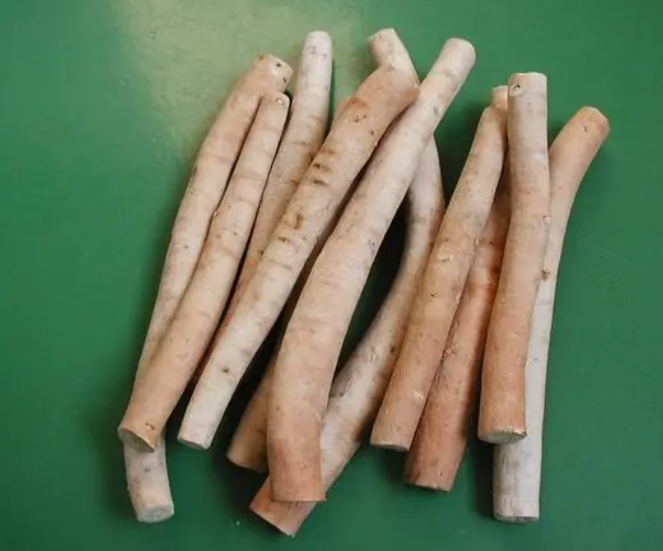

[Properties of the Medicinal Material]
Cylindrical, straight or slightly curved, with flat ends. The surface is whitish or light reddish-brown, smooth. The texture is solid, not easily broken, with sufficient powdery quality, and the cross-section is sticky to the touch, with a faint aroma and a slightly bitter, sour taste.
Traditional experience suggests that the best quality is characterized by thick, long, uniform roots, solid texture, white cross-section, sufficient powdery quality, and no white heart or cracks.
[Processing]
Bai Shao: Take the original medicinal material, remove impurities, separate into large and small pieces, wash clean, soak until semi-transparent, take out, moisten until fully transparent, cut into thin slices, and dry.
Fried Bai Shao: Take Bai Shao slices, place in a hot pan, and stir-fry over low heat until slightly yellow.
Wine Bai Shao: Take Bai Shao slices, mix with yellow wine, let it marinate for 1-2 hours until the wine is fully absorbed, then place in a hot pan and stir-fry over low heat until slightly yellow. For every 100 kg of Bai Shao slices, use 10 kg of yellow wine.
[Properties of the Slices]
Bai Shao: Appears as round thin slices. The surface is light reddish-brown or whitish, smooth. The cut surface is whitish or slightly brownish-red, with distinct layers and slightly raised vein patterns arranged radially. It has a faint aroma and a slightly bitter, sour taste.
Fried Bai Shao: Similar in shape to Bai Shao slices, with a slightly yellow or light brownish-yellow surface, some may have scorch marks. It has a faint fragrance.
Wine Bai Shao: Similar in shape to Bai Shao slices, with a slightly yellow surface, some may have scorch marks. It has a slight wine aroma.
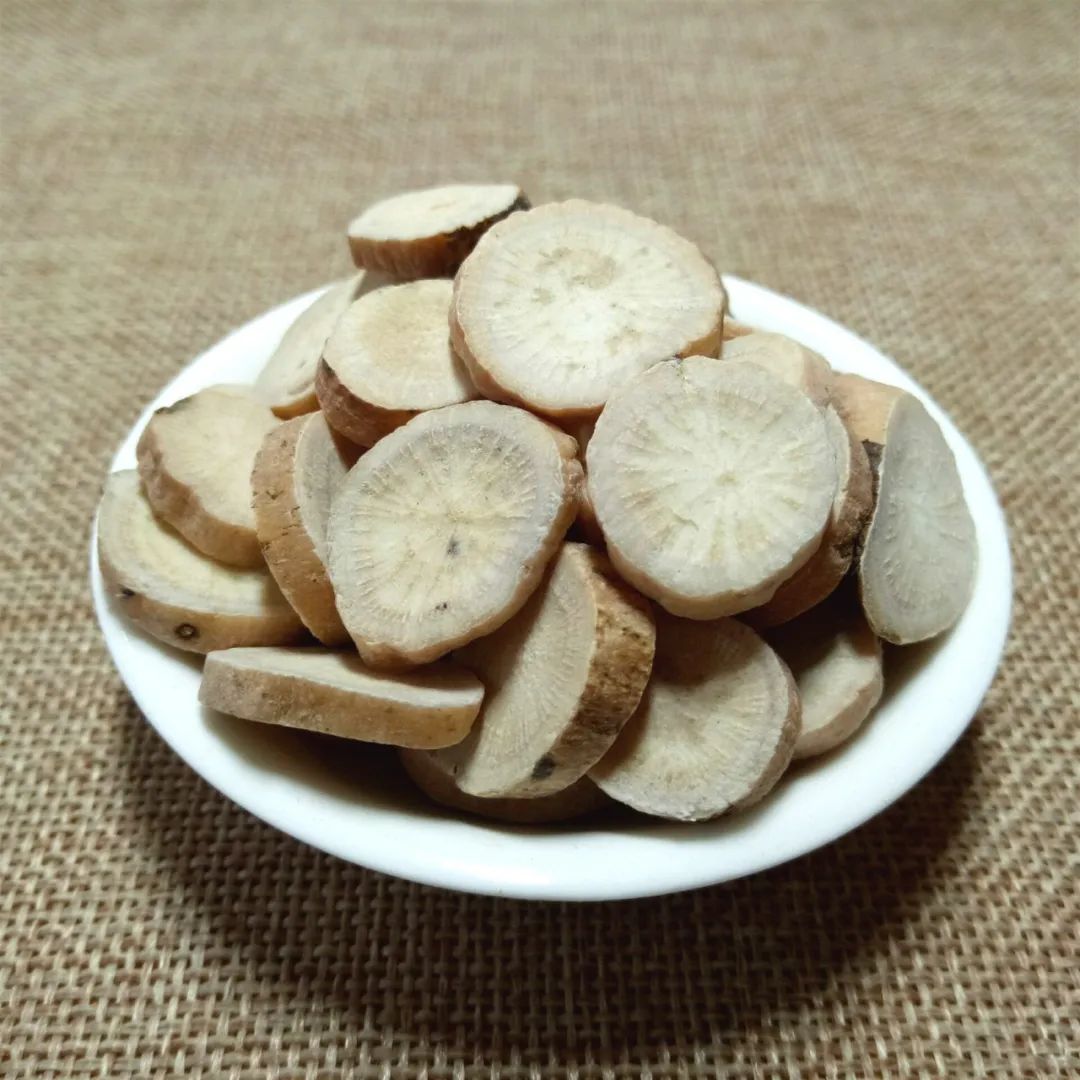


Properties of the Herb

Taste and Properties: Bitter, sour, slightly cold. Enters the liver and spleen meridians.
Main Functions and Indications:
Bai Shao: Nourishes blood and regulates menstruation, astringes yin and stops sweating, softens the liver and alleviates pain, and pacifies liver yang. Used for blood deficiency with pale complexion, irregular menstruation, spontaneous sweating, night sweats, flank pain, abdominal pain, limb cramps, and headaches with dizziness.
Fried Bai Shao: After processing, the cold nature is moderated, primarily nourishing blood and harmonizing, astringing yin and stopping sweating. Used for blood deficiency with pale complexion, abdominal pain, diarrhea, spontaneous sweating, and night sweats.
Wine Bai Shao: After processing, the cold and sour nature that attacks the liver is reduced, entering the blood aspect, good at regulating menstruation and stopping bleeding, softening the liver and alleviating pain. Used for liver qi stagnation with blood deficiency, flank pain, abdominal pain, irregular menstruation, and limb cramps.
Dosage: 6-15 g.
Chemical Components: Paeoniflorin, paeonol glycoside, 23-hydroxy betulinic acid, oleanolic acid, betulinic acid, ivy saponin, gallic acid, methyl gallate, ethyl gallate, etc.
Precautions: Should not be used with Li Lu.
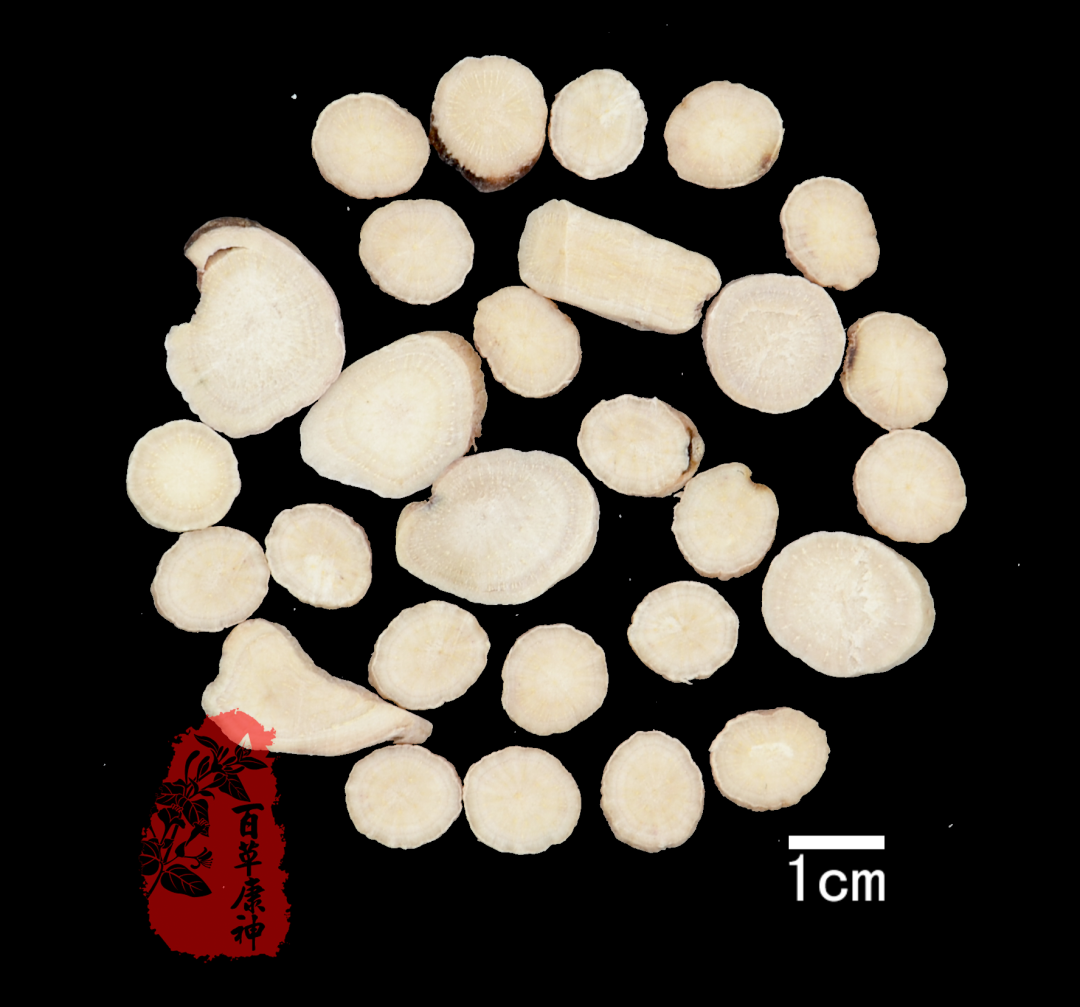


Medicinal Cuisine

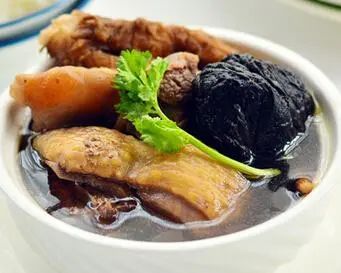

Si Wu Tang Stewed Duck Soup
Si Wu Tang is a traditional Chinese medicine formula that was first recorded in the Song Dynasty’s Taiping Huimin Heji Ju Fang (Formulas for Benefiting the People).
Function: Nourishes blood and regulates menstruation, can alleviate menstrual pain in women.
Ingredients: Old duck (600 g), Shu Di Huang (Rehmannia) (1 piece), Chuan Xiong (8 g), Dang Gui (10 g), Bai Shao (5 g), fresh ginger (4 slices)
Seasoning: Salt (to taste).
Method: First, place a clay pot with cold water, then rinse the medicinal materials to remove dust and pack them in a cloth bag. Next, place them in the clay pot along with the duck, bring to a boil over high heat, then reduce to low heat and simmer for 1.5 hours. Add salt before serving.

Summary of Materia Medica

Shen Nong’s Herbal Classic: “Mainly for evil qi causing abdominal pain… stops pain, benefits urination, and boosts qi.”
Zhen Zhu Nang: “Bai Bu Chi San, clears liver and tonifies spleen and stomach… its uses are six: calms the spleen meridian, treats abdominal pain, collects stomach qi, stops diarrhea, harmonizes blood vessels, and consolidates the pores.”
Compendium of Materia Medica: “Stops diarrhea and abdominal pain after heaviness.”
Essentials of Materia Medica: “Nourishes blood, clears liver, benefits spleen, astringes liver yin, treats abdominal pain due to blood deficiency.”
Seeking Truth in Materia Medica: “Chi Shao and Bai Shao have similar indications, but Bai Shao has the power to astringe yin and nourish the essence, while Chi Shao only disperses evil and moves blood; Bai Shao can drain wood from the earth, while Chi Shao can activate stagnation in the blood.”
That concludes today’s content. If you are interested, please follow us for more updates!

Further Reading

[1] National Pharmacopoeia Commission. Pharmacopoeia of the People’s Republic of China: 2020 Edition. Volume 1[S]. Beijing: China Medical Science Press, 2020: 108-109.
[2] Chen Hubiao, Zhao Zhongzhen. Illustrated Guide to Medicinal Materials[M]. Fuzhou: Fujian Science and Technology Press, 2010: 79.
[3] Cui Shude. Encyclopedia of Chinese Medicinal Herbs[M]. Harbin: Heilongjiang Science and Technology Press, 1998: 613.
[4] Chen Shilin, Lin Yulin. Standard Illustrated Guide to Medicinal Slices[M]. Fuzhou: Fujian Science and Technology Press, 2013: 185.
[5] Jin Shiyuan. Traditional Identification Experience of Medicinal Materials[M]. Beijing: China Traditional Chinese Medicine Press, 2010: 3.
[6] Ling Yiqi, Yan Zhenghua. Chinese Materia Medica[M]. Shanghai: Shanghai Science and Technology Press, 1984: 234-235.
Note: Some images are sourced from the internet; please contact for removal if infringing.

Produced by: Capital Medical University, School of Traditional Chinese Medicine, Medical Source Editorial Department
Text by: Xu Yang
Layout by: Xu Yang
Images by: Flora of China, Baidu Images

